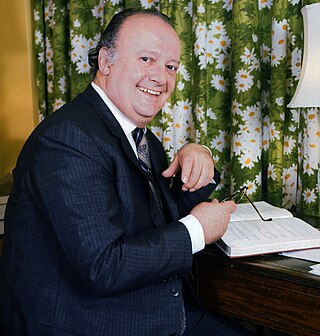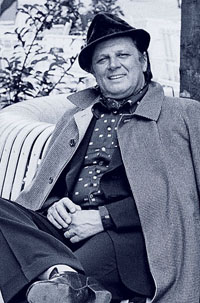Related Research Articles

Franco Corelli was an Italian tenor who had a major international opera career between 1951 and 1976. Associated in particular with the spinto and dramatic tenor roles of the Italian repertory, he was celebrated universally for his powerhouse voice, electrifying top notes, clear timbre, passionate singing and remarkable performances. Dubbed the "prince of tenors", audiences were enchanted by his handsome features and charismatic stage presence. He had a long and fruitful partnership with the Metropolitan Opera in New York City between 1961 and 1975. He also appeared on the stages of most of the major opera houses in Europe and with opera companies throughout North America.

Renata Tebaldi was an Italian lirico-spinto soprano popular in the post-war period, and especially prominent as one of the stars of La Scala, San Carlo and, especially, the Metropolitan Opera. Often considered among the great opera singers of the 20th century, she focused primarily on the verismo roles of the lyric and dramatic repertoires. Italian conductor Arturo Toscanini called her voice "la voce d'angelo", and La Scala music director Riccardo Muti called her "one of the greatest performers with one of the most extraordinary voices in the field of opera."

Mary Violet Leontyne Price is an American spinto soprano who was the first African American soprano to receive international acclaim. From 1961 she began a long association with the Metropolitan Opera. She regularly appeared at the world's major opera houses, including the Royal Opera House, San Francisco Opera, Lyric Opera of Chicago, and La Scala; at La Scala, she was also the first African American to sing a leading role. She was particularly renowned for her performances of the title role in Verdi's Aida.

Tito Gobbi was an Italian operatic baritone with an international reputation.

Leopoldine Rysanek was an Austrian dramatic soprano.

Régine Crespin was a French singer who had a major international career in opera and on the concert stage between 1950 and 1989. She started her career singing roles in the dramatic soprano and spinto soprano repertoire, drawing particular acclaim singing Wagner and Strauss heroines. She went on to sing a wider repertoire that embraced Italian, French, German, and Russian opera from a variety of musical periods. In the early 1970s Crespin began experiencing vocal difficulties for the first time and ultimately began performing roles from the mezzo-soprano repertoire. Throughout her career she was widely admired for the elegance, warmth and subtlety of her singing, especially in the French and German operatic repertories.
Patricia Neway was an American operatic soprano and musical theatre actress who had an active international career during the mid-1940s through the 1970s. One of the few performers of her day to enjoy equal success on both the opera and musical theatre stages, she was a regular performer on both Broadway and at the New York City Opera during the 1950s and 1960s.

Ettore Bastianini was an Italian operatic baritone who was particularly associated with the operas of the bel canto tradition.

Maria Zamboni was an Italian operatic soprano who had a prolific career in Italy and South America between 1921 and 1936. Admired for her vivid character portrayals and expressive singing, Zamboni was a popular and frequent performer at both La Scala and the Teatro Costanzi. Her repertoire encompassed a broad spectrum, from Verdi and Wagner heroines to French grand opera and verismo roles. She became particularly associated with the works of Giacomo Puccini and notably sang the role of Liù in the original 1926 production of Turandot.

Maria Antonietta Stella was an Italian operatic soprano, and one of the most prominent Italian spinto sopranos of the 1950s and 1960s. She made her debut in Spoleto in 1950, as Leonora in Verdi's Il trovatore, a year later at Rome Opera, as Leonora in La forza del destino, in 1954 at La Scala in Milan, as Desdemona in Otello, in 1955 at the Royal Opera House in London as Aida, and in 1956 at the Metropolitan Opera in New York City, in the same role.

Carmen Melis was an Italian operatic soprano who had a major international career during the first four decades of the 20th century. She was known, above all, as a verismo soprano, and was one of the most interesting singing actresses of the early 20th century. She made her debut in Novara in 1905 and her career rapidly developed in her native country over the next four years. From 1909 to 1916 she performed with important opera companies in the United States; after which she was busy performing at many of Europe's most important opera houses. From 1917 until her retirement from the stage in 1935 she was particularly active at the Teatro Costanzi in Rome and at La Scala in Milan. After her singing career ended, she embarked on a second career as a voice teacher. Her most notable student was soprano Renata Tebaldi.
Denise Duval was a French soprano, best known for her performances in the works of Francis Poulenc on stage and in recital. During an international career, Duval created the roles of Thérèse in Les mamelles de Tirésias, Elle in La voix humaine, and excelled in the role of Blanche de la Force in Dialogues of the Carmelites, leaving recordings of these and several other of her main roles.

Nelly Miricioiu is a Romanian-born British operatic soprano singing a large repertoire ranging from bel canto to verismo.
Daniele Barioni was an Italian opera singer who had a prolific career during the 1950s through the 1970s. Early on in his career he rose to fame as a leading tenor at the Metropolitan Opera between 1956 and 1962. Afterwards he worked primarily in opera houses and concerts throughout the United States, although he did make numerous appearances in both Europe and South America as well. Barioni was particularly associated with the operas of Giacomo Puccini and the roles of Turiddu in Pietro Mascagni's Cavalleria rusticana and Alfredo in Giuseppe Verdi's La traviata.

Gianni Raimondi was an Italian lyric tenor, particularly associated with the Italian repertory.
Mary Virginia Curtis Verna was an American operatic soprano, particularly associated with the Italian repertory.
Kenneth (Ken) Neate was an Australian operatic and concert tenor, opera producer and singing teacher, composer and author. He appeared at the Bayreuth Festival in 1963 as Loge in Das Rheingold and was noted as a dramatic tenor in German, French, and Italian repertoire in opera houses in England, France, Italy, Austria, Germany, and Australia. His operatic career lasted 38 years, followed by ten years as lecturer in Voice and Opera Studies at the Richard Strauss Conservatorium in Munich.

Norman Kelley was an American operatic tenor who had an active international career during the 1940s through the 1970s. He was notably a regular performer at the Metropolitan Opera between 1957 and 1961, and he sang in several world premieres with the New York City Opera. He also notably translated Engelbert Humperdinck's Hänsel und Gretel into English, a version first performed in 1967 and used by opera companies to this present day.
Carlos Maria Guichandut was an Argentinian baritone, and later tenor, particularly associated with heroic roles.
Nadine Renaux was a French soprano, active in opera and operetta in France from the 1930s to the 1960s.
References
- 1 2 3 "Franca Duval- Bio, Albums, Pictures – Naxos Classical Music". Naxos.com. Retrieved 2017-10-17.
- ↑ Wlaschin says 1933
- ↑ "Madame Franca DUVAL" (in French). Libra Memoria. Retrieved 31 August 2021.
- ↑ A. H. Weiler. (1958-10-24). "Movie Review - - Tosca' at Normandie". The New York Times . Retrieved 2017-10-17.
- ↑ Ken Wlaschin (2006). Encyclopedia of American Opera. McFarland & Company. ISBN 9780-7864-21091.